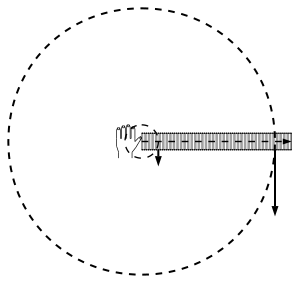Whirly tube facts for kids
The whirly tube is a fun and unique musical instrument. It's also called a corrugaphone or bloogle resonator. This instrument is made from a ribbed plastic tube or hose. It's open at both ends, and sometimes one end is wider, like a bell. You play it by spinning the thinner end in a circle.
The faster you spin the whirly tube, the higher the sound (or pitch) it makes. It can produce different musical notes, similar to a brass instrument without valves. However, it's tricky to make the very lowest notes. For concerts, people cut the tube to make sure it plays the right notes. Even though it's a wind instrument, it's often used in the percussion section for special sound effects.
How the Whirly Tube Makes Sound
A whirly tube can make three or four different musical notes when spun. Some people can even make up to seven different notes! If you have a longer tube, you can play many notes close together, almost like a melody.
When you spin the tube, air gets pulled through it. The faster the air moves, the higher the sound. The ridges inside the tube are very important. As air flows over each ridge, it creates tiny swirls, or "vortexes." When the speed of these swirls matches the natural sounds the tube can make, the sound gets louder.
The sound of a whirly tube is mostly a pure, clear tone. Tubes that are very long can be spun while holding them in the middle. You can even hold them out a car window to play them!
The faster you spin the tube, or the more ridges it has, the higher the sound it will make.
When you spin the tube, the air pressure changes. The air inside the tube moves faster at the spinning end. This makes the pressure lower there. Higher pressure air from the still end then gets pulled into the tube to fill this lower pressure area. This movement of air creates the sound.
Uses of the Whirly Tube
The whirly tube became popular in New York City in the late 1960s. Street vendors sold them under the name "Free-Ka."
Many artists and musicians have used the whirly tube in their work. For example, Peter Brooks used it in his play A Midsummer Night's Dream. Musicians like Paul Simon and Macy Gray have also featured it in their songs. The Cadets Drum and Bugle Corps used it in 2011.
Composer Peter Schickele used the whirly tube in his funny P. D. Q. Bach compositions. He even called it the lasso d'amore, joking that Viennese cowboys used to make music by spinning their lassos!
Another version of the instrument is called a cugaphone. This is made by attaching a trumpet mouthpiece to a long plastic tube with a kitchen funnel at the end. You can change the sound by moving the funnel or spinning it around your head. This creates a "Doppler effect," where the sound changes as it moves towards or away from you.
No one knows for sure who invented the whirly tube. However, Frank Crawford from UC Berkeley helped understand how it works. He also came up with a way to play smaller tubes by blowing into them, calling it a corrugahorn. He found that tubes about 3/8-inch wide work best for this.


